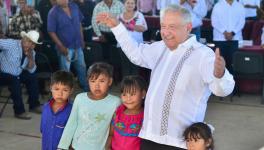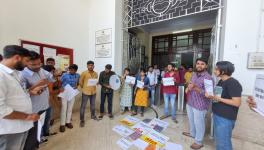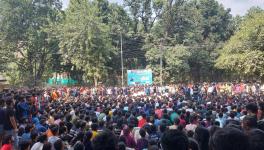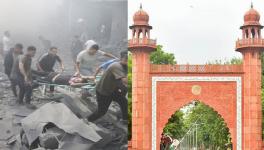43 months without the 43 Ayotzinapa students
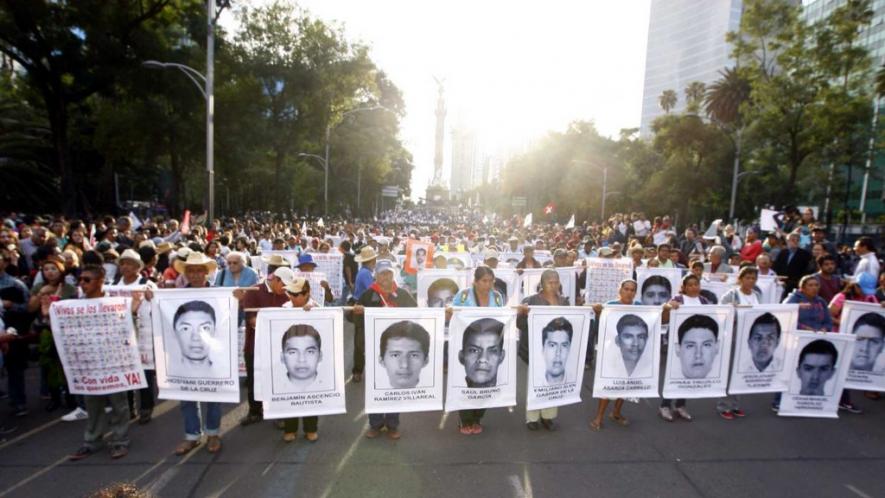
Today marks 43 months since the forced disappearance of 43 students from the Ayotzinapa Rural Teachers’ College. 43 long months during which the family members of the disappeared have used every recourse possible – mass protest, international denouncements, letters, solidarity campaigns, even running the New York City marathon. 43 months of effort and persistence, despite which the Mexican state led by Enrique Peña Nieto still refuses to reveal the entire truth about what happened on the night of September 26, 2014, and refuses to take real action to punish the government actors that are clearly implicated in the mass disappearance.
The 43 were among the 100 students heading to the city of Iguala in Guerrero, a State in the Southwest of Mexico and the third poorest in the country. The long, violent, chaotic and bloody night was one of the worst in Mexico’s recent history, and is tragically emblematic of the general trend in the country, where over 32,000 people have disappeared, 42% of whom are between the ages of 15 and 29.
When the students arrived at Iguala, they engaged in the traditional practice of commandeering buses in order to travel to Mexico City for the annual protest commemorating the October 2 Tlatelolco massacre. The Tlatelolco massacre took place in 1968 and while the government claims that only around 60 students were killed, human rights organizations estimate that the real number of students killed was over 300.
After securing five buses, the students headed back to Ayotzinapa. Shortly after, law enforcement agencies and other armed actors launched a calculated and coordinated assault on the student caravan. The local and federal police began shooting at the buses and trying to impede their path on the different routes they had been travelling on. At this point, at least two students were killed in the police gunfire and dozens more were injured. The students tried to resist and escape but around 10 pm, the 43 students were detained and taken away in police cruisers, never to be seen again. Other vehicles on the road that night, including one carrying a high school football team, were also attacked by the police, leading to three deaths and many more injuries.
At 11 pm, some students, who had taken cover, began to emerge from the hills and several journalists arrived. A small press conference was held but shortly after, armed men arrived and began to open fire on the students, teachers and journalists. One of the students who was present at the press conference, Julio César Mondragón, was brutally murdered. He was found with his facial skin and eyes removed and internal organs ruptured.
The following days, the surviving students and family members of the disappeared students began to search for them in local police stations and jails, with no luck. They began to protest, arriving at the doors of the Mexican government, demanding answers about their classmates, sons and comrades. Hundreds of thousands of people across Mexico and the world joined them in their protest. Students and teachers across the country held strikes in solidarity with the students and their families and their search for justice. The massive demonstrations called for the resignation of Mexican President Enrique Peña Nieto and for the immediate restoration of the students to freedom: “Vivos se los llevaron, vivos los queremos” “They were taken alive, we want them back alive!”.
Meanwhile, details emerged about the case that exposed the role of government officials, both at the local and federal level, in planning and executing the incident, as well as the participation of the Mexican army. Though dozens of police and several local government authorities have been arrested in connection to the case, the government refuses to reveal the entire truth behind what happened that night.
On November 7, a little more than a month after the disappearances, the Attorney General of Mexico, Murillo Karam, announced the federal government’s version of the events. He claimed that the local police handed over the students to members of the Guerreros Unidos cartel, who then killed them, incinerated their bodies in a rubbish dump, and disposed of the ashes and bone fragments in a river. Members of the Guerreros Unidos publicly confessed to the crime. For the government, the case was closed.
However, family members maintain that this version is false and several international human rights organizations have questioned the veritability of this version and the integrity of the government investigation. Family members believe that the federal government and the army were directly involved and that the government continues to cover-up this up, painting it as a case of corrupt local police personnel colluding with drug cartels.
43 months later, the family members of the students and the surviving classmates refuse to rest. They continue to demand justice and truth from the Mexican government. Their calls for justice and accountability from the Mexican government are not limited to the case of the 43 students. They also demand justice for the tens of thousands of the disappeared in Mexico and denounce the government’s systematic role in these atrocities. They have also condemned the Internal Security Law passed on December 22, 2017, which gives the army greater powers to fight crime expands the powers of the army to act internally while fighting crime, a worrying prospect given its role in the Ayotzinapa case.
Meanwhile, the violence in Mexico continues. Civilians, who are caught in the crosshairs of cartel violence, corrupt governments and a treacherous army and police, are the worst-affected. Just last week, the Prosecutors of the Jalisco state of Mexico announced that 3 film students, who had been kidnapped in March, had been beaten, tortured and their bodies dissolved in acid by the New Generation cartel.
Get the latest reports & analysis with people's perspective on Protests, movements & deep analytical videos, discussions of the current affairs in your Telegram app. Subscribe to NewsClick's Telegram channel & get Real-Time updates on stories, as they get published on our website.










